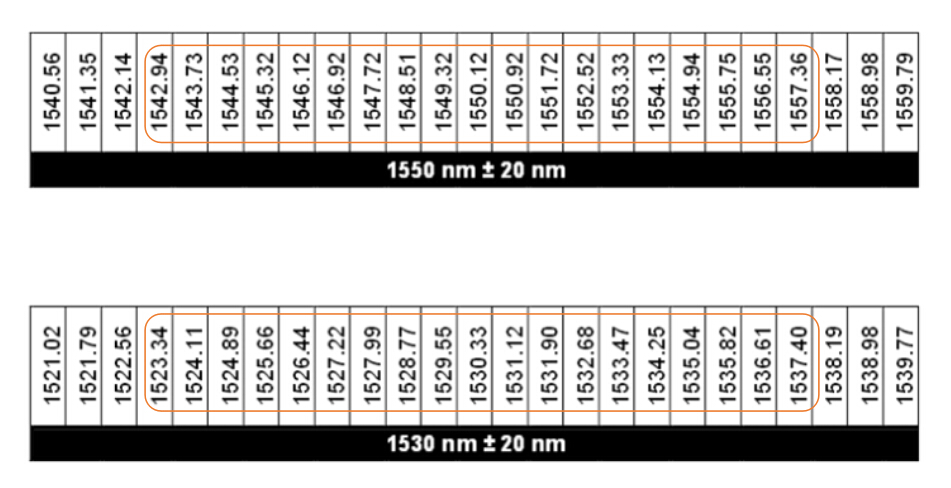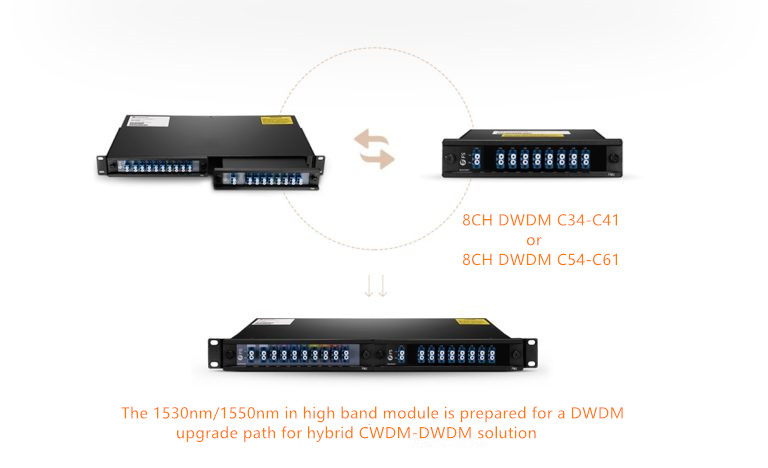Should I choose a medium capacity but more cost-effective CWDM solution, or to adopt the cost-prohibitive DWDM approach with comparably enhanced capacity? This is a problem that consistently faced by WDM technology users. The wrong decision, however, may inevitably lead to bandwidth shortage or even potential bankruptcy derived from unnecessary capacity investment. This article introduces the hybrid CWDM-DWDM solution that combines both CWDM and DWDM technologies within a single system, helping decrease costs and simplify installation while maintain the flexibility to upgrade.
Hybrid CWDM-DWDM System Explanation
Hybrid CWDM-DWDM system utilizes the technology to merge DWDM and CWDM traffic seamlessly at the optical layer. Which allows carriers to add many channels to networks originally designed for the more limited CWDM capacity and reach. In other words, hybrid CWDM-DWDM system is used to empower CWDM system by integrating CWDM and DWDM equipment. Hybrid CWDM-DWDM system deliver true pay-as-you-grow capacity growth and investment protection. It offers a simple, plug-and-play option for creating hybrid system of DWDM channels interleaved with existing CWDM channel plans.
Benefits of Hybrid CWDM-DWDM System
Hybrid CWDM-DWDM system typically provides three benefits for carriers and users:
- Reduced Cost: CWDM is more cost-effective than DWDM due to the lower cost of lasers and the filters used in CWDM modules. This cost saving becomes quite significant for large deployments.
- Pay-As-You-Grow: Adding one new channels at a time allows for on-demand service introduction with minimal initial investment—a critical feature in terms of reduced OPEX and CAPEX spending.
- Investment Protection: Carriers and end-users need always to bear the future growth in mind. With hybrid CWDM-DWDM system, carriers no longer have to choose between CWDM and DWDM—both options can be deployed simultaneously or as part of future growth. This module can be used in either CWDM or DWDM system. Current capital investment can always be used in the upgraded network.
How to Deploy Hybrid CWDM-DWDM System
The CWDM wavelength grid typically has 16 channels spacing at 20 nm intervals, with 8 channels (1470 nm-1610 nm) of them are most commonly used. Within the pass band of these channels, it is capable of adding 25 100 GHz spaced DWDM channels under the 1530nm envelope and 25 more under the 1550nm envelope. However, it is not so practical to add 25 DWDM channels in the pass-band of both the 1530nm and 1550nm CWDM channels. DWDM filter technology does allow 38 additional channels to clear the CWDM archway, which is shown as following.

To add more DWDM channels to the MUX side of the conventional CWDM system, one need to plug in a DWDM MUX with the appropriate channels under the pass band of the existing CWDM filters. The picture below illustrates the configuration of a CWDM system upgraded with 38 additional 100 GHz spaced DWDM channels. This hybrid CWDM-DWDM system consists of 38 DWDM channels and the existing 6 CWDM channels. The equipment required to go from the first architecture to the second are 2 DWDM MUX/DEMUXs, as well as the additional transmitter and receiver pairs. The additional loss incurred by the upgrade is equal to the additional loss of the DWDM elements and the additional connection points.

Flexible Hybrid CWDM-DWDM System Solution by FS.COM
The most vital elements concerning hybrid CWDM-DWDM system are the CWDM MUX/DEMUX and DWDM MUX/DEMUX. FS.COM developed and introduces FMU series products to facilitate installation and operation of WDM MUX/DEMUX. The prominent feature of this series products is that they combine the MUX/DEMUX into half-U plug-in modules, which can be installed in a 1U rack. As for hybrid CWDM-DWDM system, a FMU CWDM MUX/DEMUX and a DWDM half-U plug-in module can be installed together in a FMU 1U rack chassis, facilitating connections of these two modules while allowing for better cable management and network operation in hybrid CWDM-DWDM system.

Conclusion
Hybrid CWDM-DWDM system generally offers a cost-effective and future-proofing approach for service providers and end-users, by overcoming the obstacles faced by users of WDM technology today, providing a starting platform that scales smoothly and protecting the investment. A user can commence with the more cost-effective CWDM technology and then later add DWDM in the when the capacity is required. FS.COM FMU series WDM solution makes the process even easier and more flexible. For more information, please visit www.fs.com or contact sales@fs.com.
No comments:
Post a Comment